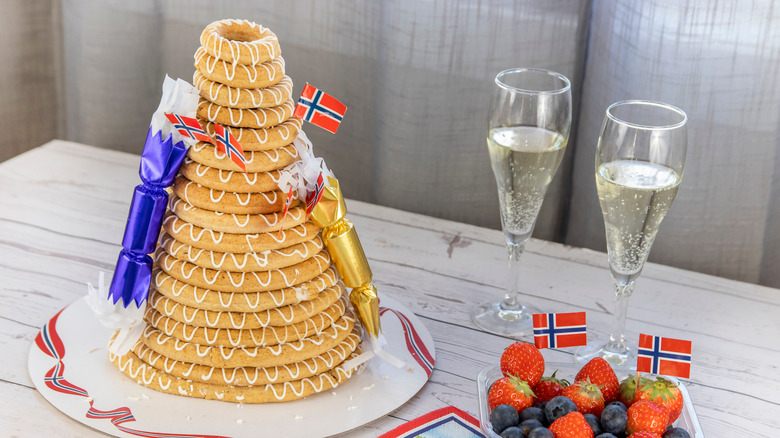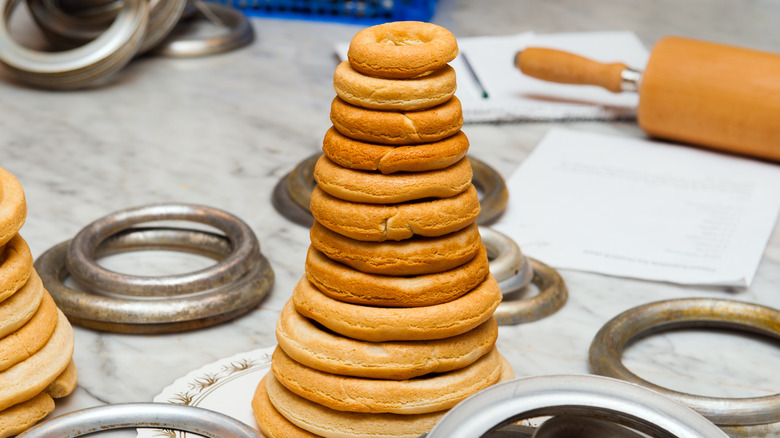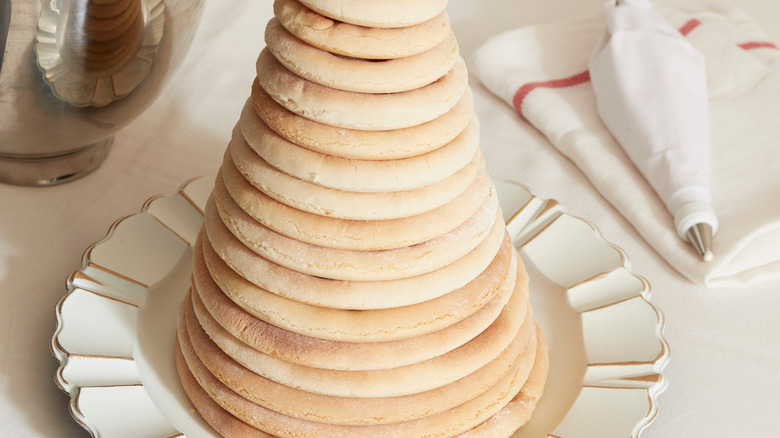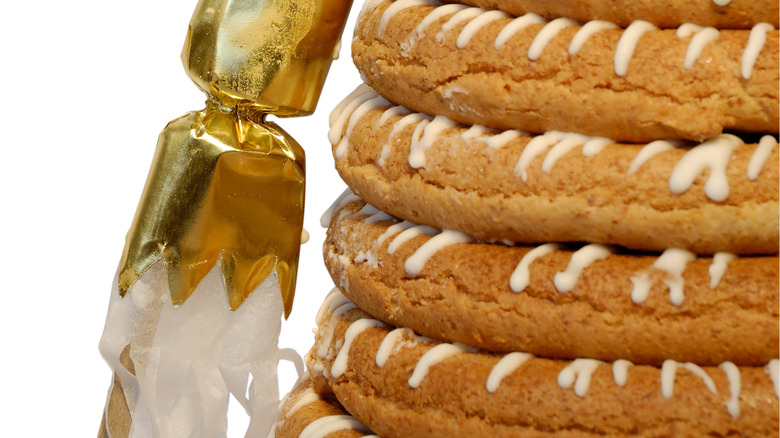Kransekake: The Whimsical Cake You Can Hide A Bottle Of Champagne In
Perhaps you're familiar with King Cake, the Mardi Gras treat baked with a hidden toy or animal inside. Whoever finds the inserted addition is crowned royalty for the day, but this isn't the only cake with a surprise inside. The Norweigan kransekake takes this game a step further: Imagine finding an actual bottle of wine or champagne in the middle of your cake.
Made up of stacked rings, the cake makes not only a captivating centerpiece but is equally delicious to share. Think of almond meringue crossed with light marzipan. Though this kind of cake takes some time to prepare, Martha Stewart explains it is a straightforward recipe and with advance preparation, the gluten-free dough can be decorated for any special event. Often presented at weddings, birthdays, and holidays, the cake allows guests to take what they want from the 18 stacked cake rings.
Kransekake translates to "wreath cake" in English, but Random Times insists it's not an accurate description. Where did this cake come from — and why has it become a hiding place for champagne?
History of kransekake
The history of this cake is a bit unclear. Eclectic Home and Life identifies one origin tale from Greece. As a form of thanks, Amalthea, who raised Zeus, received a horn from the gods, and the symbolic gift became associated with abundance and good health. Kransekake is rumored to derive from one ringed cake called overflødighetshorn, which is also made of dough rings but set on its side like a cornucopia. Since the cornucopia is a symbol of abundance, the dessert is filled with candy and treats (per Det søte liv), which may be where the tradition of filling the inside of kransekake with champagne, candy, and more came from. Regardless of who made the first vertical tower of rings, Vogue Scandinavia observes these cakes have been found on Scandinavian tables during festival occasions for over two centuries.
The name of the elaborate-looking kransekake has taken regional forms; while Norwegians call the treat kransekake, Danes have named it kransekage, and Swedes refer to the cake as kranskaka, notes Epicurious. In Norway, Shetland explains the cake is enjoyed on the country's Constitution Day. Depending on what is being celebrated and when, the items placed inside the rings of the decorated cake can vary.
How kransekake is made
Special pans can be purchased to make the rings of cake that will be stacked and decorated, notes Epicurious. As Shetland notes, the ring forms are often gifted among families.
The cake dough is made of ground almonds, powdered sugar, egg whites, and flavorings (basically a heartier version of meringue) and the icing is made from sugar, vinegar, and egg whites. Measure everything by weight, recommends Paleo Pantry, as ground almonds can skew bakers' ratios. When baked, the cake has a crisp outer layer and is soft and chewy on the inside, notes Shetland. If you like the taste of marzipan, you'll love this, but as Epicurious notes, the marzipan flavor is enhanced with hints of orange and rosewater.
Once baked, each ring is carefully stacked, with the largest rings on the base of the cake and smaller rings on the top. Cakes are decorated with icing to match the occasion, often with flags or brightly colored candies. Since it's a large cake, there's a good chance you won't be able to polish it off in one go. Fortunately, it can be frozen and enjoyed later.
A cake for celebrations
Kransekake isn't sliced like a regular cake, notes My Wedding, especially when served at weddings. The newlyweds basically play a game of cake Jenga and are the first to remove rings from the top of the cake. The number of rings that stick to the removed pieces is thought to indicate how many children the two can expect. Once the married duo has had their fill, the rest of the rings are served to wedding guests.
Revealing the inside of the cake is always an exciting moment at a wedding, but in Finland, the cake reveal is even more dramatic, as the removed rings reveal a bottle of champagne, notes Epicurious. After guests have uncovered the bottle, the cork is popped, and a toast is shared among revelers. Other goodies can also be placed inside: cookies, chocolate, or candies depending on the event and the guests present. For the Christmas holidays, the cake is often decorated to look like a festive tree.
Regardless of what you decide to fill it with, if you're looking to make an impression at your next party, a kransekake is guaranteed to turn heads.



